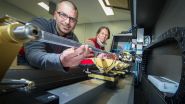(Press-News.org) Researchers at Children's Hospital Los Angeles have demonstrated that adolescents and young adults with congenital adrenal hyperplasia (CAH) have significantly increased amounts of abdominal fat tissue, placing them at greater risk for harmful conditions linked to obesity, including cardiovascular disease (CVD).
Their study, which reveals new information about the role of abdominal fat in patients with CAH and points to a need for targeted prevention and therapeutics to avoid these adverse effects, will be published online June 10, 2015 by The Journal of Clinical Endocrinology & Metabolism.
"We see an increased prevalence of obesity in adolescents with CAH, even above the alarmingly high rates already seen in children," said principal investigator Mimi S. Kim, MD, co-director of the Congenital Adrenal Hyperplasia Clinic of the Division of Endocrinology at CHLA. "We also see that these young patients have a more unfavorable abdominal fat distribution, which could actively promote cardiovascular disease."
CAH is an inherited disorder that affects the adrenal glands, causing the production of excess male sex hormones called androgens. Studies have suggested that the hormonal imbalances inherent to CAH, as well as treatments for the disease - including life-long glucocorticoid therapy to suppress adrenal androgen production - are likely contributors to obesity and CVD risk in these patients.
Over the past two decades, there has been an increasing focus on specific types of fat accumulation in obese individuals. Visceral adipose tissue, accumulated around the body's organs, is of particular concern, because it is highly inflamed in individuals with metabolic syndrome and may produce inflammatory substances associated with CVD. The research team used computed tomography (CT) imaging to quantify specific deposits of both visceral and subcutaneous adipose tissue, the latter found directly below the skin. They also measured metabolic and inflammatory markers, to find out more about the metabolic role of abdominal adipose tissue in patients with CAH.
In addition to increased abdominal fat, they found a higher proportion of pro-inflammatory visceral adipose tissue than of subcutaneous fat in these patients.
Kim explained that increased abdominal fat tissue in CAH is associated with insulin resistance and metabolic syndrome; cell signaling proteins that can stimulate regions of the brain regulating appetite; and inflammation.
"Inflammation is a risk factor for cardiovascular disease in itself," added Kim, who is also an investigator with The Saban Research Institute and assistant professor of Clinical Pediatrics in the Keck School of Medicine of the University of Southern California. "It is possible that adolescents and young adults with CAH have systemic low-grade inflammation similar to that found in obese individuals without the disorder."
INFORMATION:
Additional contributors include Anna Ryabets-Lienhard, DO, Anh Dao-Tran, MPH, Steven D. Mittelman, MD, PhD, Vicente Gilsanz, MD, PhD, Sheree M. Schrager, PhD, and Mitchell E. Geffner, MD, all of Children's Hospital Los Angeles. The research study was supported by the NIH grants KL2TR000131 and 1UL1RR031986; and The Abell Foundation.
About Children's Hospital Los Angeles
Children's Hospital Los Angeles has been named the best children's hospital on the West Coast and among the top five in the nation for clinical excellence with its selection to the prestigious U.S. News & World Report Honor Roll. Children's Hospital is home to The Saban Research Institute, one of the largest and most productive pediatric research facilities in the United States. Children's Hospital is also one of America's premier teaching hospitals through its affiliation since 1932 with the Keck School of Medicine of the University of Southern California.
For more information, visit CHLA.org. Follow us on our blog http://researchlablog.org/.
SAN FRANCISCO - Innovative vaccine and tumor research will be unveiled at the American Association of Pharmaceutical Scientists' (AAPS) National Biotechnology Conference (NBC). The meeting takes place Monday, June 8- Wednesday, June 10 at the San Francisco Marriott Marquis.
This year's conference is organized into five meeting workstreams: Chemistry, Manufacturing, and Controls (CMC) including Formulation, Characterization, Stability and Biomanufacturing; Research and Discovery; Clinical Pharmacology, Pharmacokinetic/Pharmacodynamic (PK/PD), and Bioanalytics; Regulatory; ...
Was it a massive migration? Or was it rather a slow and persistent seeping of people, items and ideas that laid the foundation for the demographic map of Europe and Central Asia that we see today? The Bronze Age (about 5,000 - 3,000 years ago) was a period with large cultural upheavals. But just how these upheavals came to be have remained shrouded in mystery.
Assistant Professor Morten Allentoft from the Centre for GeoGenetics at the Natural History Museum of Denmark at the University of Copenhagen is a geneticist and is first author on the paper in Nature. He says:
- ...
An international team of scientists has found a dramatic ice sheet collapse at the end of the ice age before last caused widespread climate changes and led to a peak in the sea level well above its present height.
The team found the events 135,000 years ago caused the planet to warm in a different way to the end of the most recent ice age about 20,000 to 10,000 years ago.
The findings will help scientists understand the processes that control Earth's dramatic climate changes, said the leader of the study, Dr Gianluca Marino of The Australian National University (ANU).
"We ...
Several neurodegenerative disorders are caused by aggregates of a single protein known as alpha-synuclein. In collaboration with CNRS and the University of Antwerp, KU Leuven neurobiologists have discovered that the shape of these aggregates - 'cylinders' or 'ribbons' - determines whether a patient develops Parkinson's disease or Multiple System Atrophy, respectively.
Typical of neurodegenerative disorders is the disrupted communication between brain cells together with a loss of cells in specific brain regions. For some brain diseases this phenomenon is linked to a ...
The discovery of how a group of bacteria rapidly adapts to changing growth conditions could have implications for future antibiotic development, according to research at the University of Oxford and the University of York.
Led by Professor Colin Kleanthous at Oxford and Dr Christoph Baumann at York, the research which also involved key collaborators Mark Sansom at Oxford and Jacob Piehler at the University of Osnabrück, is published in Nature.
Gram-negative bacteria are a major cause of disease, in part because they have a robust outer membrane that protects ...
A University of Manchester led trial of a new psoriasis drug has resulted in 40 percent of people showing a complete clearance of psoriatic plaques after 12 weeks of treatment and over 90 percent showing improvement.
The research tested 2,500 people with psoriasis. Half were given a new drug - ixekizumab - either once every two or four weeks. The other half were given a placebo or a widely used drug for psoriasis called etanercept.
The ixekizumab groups showed quick and extensive improvements in their condition, outperforming the groups on placebo or etanercept. Around ...
wo NASA satellites provided a look inside and outside of Tropical Cyclone Ashobaa. NASA and JAXA's GPM satellite observed rainfall rates and cloud heights identifying powerful thunderstorms within the cyclone, and NASA's Aqua satellite provided an overall look at Ashobaa's cloud extent.
The Global Precipitation Measurement (GPM) core observatory had an excellent view of Tropical Cyclone Ashobaa in the Arabian Sea over on June 8, 2015 at 2131 UTC (5:31 p.m. EDT). As expected, Tropical Cyclone Ashobaa was more powerful than when seen by GPM earlier in the day. GPM's Microwave ...
Genetically modified fish that overexpress growth hormone have been created for more than 25 years, but unlike many domesticated crops, transgenic fish have yet to enter commercial production. Because of the difficulty inherent in eradicating an established fish population, efforts are under way to model the threat posed by possible invasions.
In an article for an upcoming issue of BioScience, a team of government and academic researchers, led by Robert Devlin of Fisheries and Oceans Canada, examined the possible outcomes of an accidental release of transgenic fish. Their ...
The air around us is a chaotic superhighway of molecules whizzing through space and constantly colliding with each other at speeds of hundreds of miles per hour. Such erratic molecular behavior is normal at ambient temperatures.
But scientists have long suspected that if temperatures were to plunge to near absolute zero, molecules would come to a screeching halt, ceasing their individual chaotic motion and behaving as one collective body. This more orderly molecular behavior would begin to form very strange, exotic states of matter -- states that have never been observed ...
Most galaxies are clumped together in groups or clusters. A neighboring galaxy is never far away. But this galaxy, known as NGC 6503, has found itself in a lonely position, at the edge of a strangely empty patch of space called the Local Void.
The Local Void is a huge stretch of space that is at least 150 million light-years across. It seems completely empty of stars or galaxies. The galaxy's odd location on the edge of this never-land led stargazer Stephen James O'Meara to dub it the "Lost-In-Space galaxy" in his 2007 book, Hidden Treasures.
NGC 6503 is 18 million ...



